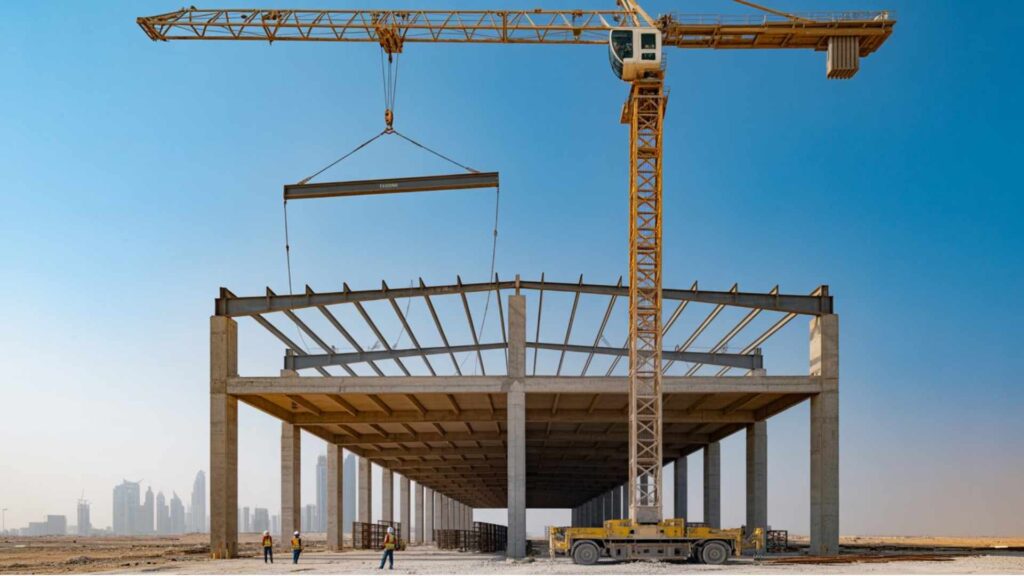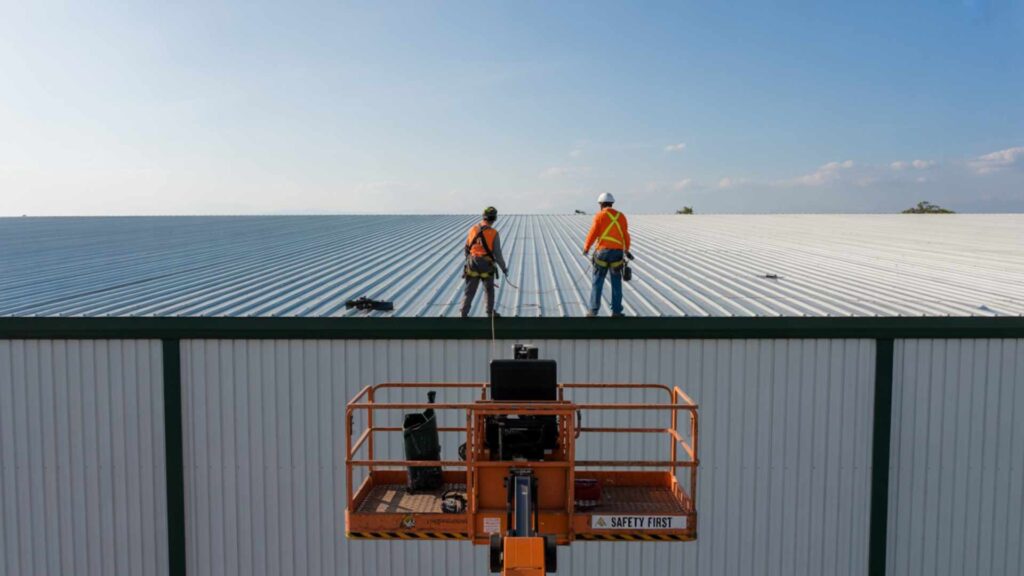Warehouse construction cost in Dubai is influenced by a mix of economic, regulatory, and infrastructural factors, and there’s no one-size-fits-all figure. Understanding each of these elements in detail can help developers avoid budget overruns and ensure compliance with local laws.
Table of Contents
Why Warehouse Construction Is Booming in Dubai
Dubai’s economy is built on trade, logistics, and free zone business models. With mega infrastructure projects like Dubai South and the continuous expansion of Jebel Ali Port, the need for modern warehouses is rising sharply. Local distributors, multinational exporters, and logistics providers are all seeking scalable storage solutions close to key transport routes.
This surge has not only driven demand but also pushed developers to explore new designs like automated warehouses, temperature-controlled facilities, and multi-level storage centers. As these needs evolve, the cost of construction adjusts accordingly.
The cost of building a warehouse in Dubai reflects this dynamic market shift. Costs are not just about square meters but also facility capability, compliance, and efficiency.
What’s the Average Cost of Constructing a Warehouse in Dubai?
As of 2025, the warehouse construction cost in Dubai typically ranges between AED 1,200 to AED 2,000 per square meter for standard builds. But that’s just the base price. Final costs can rise substantially depending on:
- Type of warehouse: cold storage, dry storage, bonded warehouse, etc.
- Structural materials used: steel frames, RCC, PEB structures
- Degree of automation
- Land preparation and soil conditions
- Sustainability features such as solar panels or energy-saving insulation
A basic shell structure may fall on the lower end, while a fully automated, air-conditioned warehouse with racking systems and fire protection may hit the higher range or beyond.
With construction prices projected to increase by 2–5% in 2025 due to rising demand and raw material costs, it’s critical to understand these variables when estimating your warehouse construction cost.
Here’s a general breakdown of average construction costs based on warehouse type:
Warehouse Type | Estimated Cost (AED/sq.m) |
Basic Shell Structure | 1,200 – 1,400 |
RCC Structure | 1,400 – 1,700 |
Cold Storage Facility | 1,800 – 2,200+ |
Multi-story Warehouse | 1,600 – 2,200+ |
Automated Smart Warehouse | 2,000 – 2,500+ |
Major Factors That Influence Warehouse Construction Costs in Dubai
1. Land Cost and Location
Location plays a major role. Warehouses in Jebel Ali, Al Quoz, or Ras Al Khor tend to be more expensive due to proximity to ports or urban centers. Meanwhile, Dubai Industrial City and Dubai South offer more affordable land with excellent connectivity.
Leasing land in a free zone might cost more upfront, but tax benefits and streamlined import/export procedures may balance the total investment.
2. Design Specifications
Basic square-shaped storage units differ significantly in cost from customized warehouses designed for vertical racking, cold storage, or integrated office spaces.
Design elements that affect cost:
- Clear height (typically between 7–14 meters)
- Mezzanine floors for offices or sorting areas
- Loading/unloading docks and bay doors
- HVAC systems for temperature control
All of these directly influence the warehouse construction cost in Dubai and must be considered at the design stage.
3. Type of Construction and Materials Used
Material selection greatly affects both the cost and the long-term performance of your warehouse.
- PEB (Pre-engineered buildings): Quicker to build, cheaper per sq.m, and ideal for large layouts
- RCC (Reinforced Concrete Construction): Offers better insulation, structural durability, and fire resistance, but at a higher cost
Roofing, insulation, slab thickness, and exterior cladding also factor into the budget. For example, a warehouse requiring controlled humidity might need sandwich panel roofing and vapor barriers—both premium features.
Advanced materials raise the warehouse construction cost in Dubai, but they also help in long-term energy savings and sustainability compliance.
4. MEP (Mechanical, Electrical, Plumbing) Systems
MEP systems can consume 20–35% of the total warehouse construction budget. Warehouses today need to comply with civil defense standards, energy efficiency norms, and fire safety regulations, all of which require significant electrical and mechanical investments.
Some components include:
- Sprinkler and smoke detection systems
- Industrial lighting and emergency power
- HVAC systems for temperature-controlled storage
- Water supply and drainage for sanitation areas
Whether it’s installing solar panels or low-voltage distribution boards, each technical enhancement increases the warehouse construction cost in Dubai but can improve the facility’s operational lifespan and compliance.
5. Compliance and Permit Costs
Dubai’s regulatory framework ensures safety, quality, and environmental accountability in warehouse development. However, that means developers must factor in costs related to:
- Dubai Municipality approvals
- Fire department (DCD) clearances
- Civil defense certifications
- Environmental permits (especially for hazardous goods or chemicals)
Delays in approvals or incorrect documentation can cause project standstills and financial loss. Partnering with experienced consultants or design-build contractors can help manage these stages efficiently.
Such regulatory costs may not be high in absolute terms, but have a significant impact on timelines and execution. These soft costs also contribute to the total warehouse construction cost in Dubai and should not be overlooked.
6. Labor and Project Timeline
Labor is relatively cost-effective in Dubai due to government-regulated wage structures. However, the need for specialized workers such as welders, HVAC technicians, or automation engineers can add to total labor costs.
A typical warehouse construction project in Dubai can take 6 to 12 months, depending on:
- Design complexity
- Material lead time
- Site readiness
- Permit approvals
Fast-track projects might require more manpower or modular solutions, raising upfront costs for quicker returns. Accelerating timelines will inevitably affect the warehouse construction cost in Dubai, especially in competitive industrial zones where time-to-market is critical.
Hidden Costs You Shouldn’t Ignore
Many warehouse projects in Dubai go over budget due to underestimating hidden or indirect costs. These include:
- Soil testing and ground leveling: Particularly for desert land or reclaimed areas
- Connection to DEWA (Dubai Electricity and Water Authority)
- Import duties on materials (if sourced internationally)
- Security systems, automation controls, and IoT sensors
- Insurance and safety gear for construction workers
All these components, though not part of the core construction, directly impact the total investment. Understanding them helps in building a more accurate picture of the warehouse construction cost in Dubai.
Cost Optimization Tips for Developers
Constructing a warehouse is a long-term investment, and optimizing it requires balancing cost with function. Here are some tips:
- Opt for design-build contracts: It integrates design, engineering, and construction into one service provider, minimizing communication gaps and cost miscalculations.
- Choose modular or PEB designs: Especially for logistics and storage units that don’t require high insulation
- Invest in energy-efficient lighting and ventilation: Higher upfront cost, but lower running cost
- Lease land in emerging industrial zones: Cheaper rates with potential for future infrastructure growth
Each of these approaches contributes to long-term efficiency while keeping the warehouse construction cost in Dubai within acceptable limits.
Conclusion
The cost of constructing a warehouse in Dubai involves more than just square footage, it reflects a series of strategic choices. From land and layout to technical installations and compliance, every factor plays a role in shaping your final budget. While the average construction cost per square meter gives a baseline, real-world figures depend on location, design, and operational requirements.
From expanding manufacturing capacity to scaling logistics operations or stepping into industrial real estate, a clear understanding of construction cost dynamics is key to achieving a budget-aligned, future-ready facility.
Looking to build a warehouse in Dubai that balances quality, speed, and cost?
Dura Altaj delivers end-to-end expertise in warehouse design and construction across Dubai’s key industrial zones. From cold storage units to high-clearance distribution hubs and fully integrated logistics centers, the focus is on optimizing every square meter.


